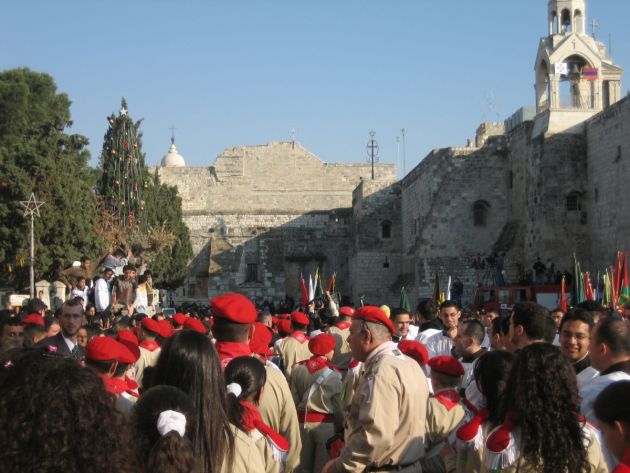Pilgrims pack Bethlehem to celebrate Christmas to pipe bands and trumpets

Pilgrims from across the world gathered in Bethlehem on Christmas Eve, queuing to see the grotto where Jesus is believed to have been born and watching a parade led with pipes and trumpets in what is believed to be the biggest celebration in years.
Midnight mass began in Bethlehem later, while Pope Francis held mass at the Vatican as Christians celebrate the traditional day of Jesus's birth.
Celebrating "Mass During the Night" on Christmas Eve in St. Peter's Basilica, Pope Francis said Jesus' birth in a manger teaches humanity to share their lives with their brothers and sisters in need.
"In Bethlehem, we discover that God does not take life, but gives it," said the Pope.
In his homily at Christmas Eve Mass, Francis said the location of Jesus' birth marks a turning point in the course of history.
He noted that Bethlehem means "house of bread", and that Mary laid Jesus in a manger.
"It is as if he wanted to say: 'Here I am, as your food'."
The Pope said in his homily Jesus gives us his very self, teaching us to live our lives in a new way: "not by devouring and hoarding, but by sharing and giving."
Francis said the birth of Christ pointed to a new way to live "not by devouring and hoarding, but by sharing and giving".
He said, "Let us ask ourselves: Do I really need all these material objects and complicated recipes for living? Can I manage without all these unnecessary extras and live a life of greater simplicity?
"For many people, life's meaning is found in possessing, in having an excess of material objects. An insatiable greed marks all human history, even today, when, paradoxically, a few dine luxuriantly while all too many go without the daily bread needed to survive."
BAGPIPE BAND
In Bethlehem in the occupied West Bank, the Palestinian scouts and a bagpipe band paraded in Manger Square across from the Church of the Nativity, built where Christians believe Mary gave birth to Jesus.
Palestinian president Mahmud Abbas was to be among dignitaries attending the ceremony.
This year, visitors viewed the Church of the Nativity's newly restored mosaics after they were recently cleaned and repaired in a major project.
The first church was built on the site in the fourth century, though it was replaced after a fire in the sixth century.
Bethlehem is located near Jerusalem but cut off from the city by Israel's separation barrier.
It has seen an increase in visitors this season after several down years due to unrest linked to the Israeli-Palestinian conflict, AFP news agency reported.
Palestinian tourism officials and hotel operators have reported their highest numbers of vistors in years.
"This year is much more calm, much better than last year," said Abeer Nasser, a Palestinian from the nearby town of Beit Sahour who was with her son and daughter and was planning to attend midnight mass.
"Every year I feel more in the mood to celebrate despite the political situation," the 37-year-old added, referring to the Israeli occupation.
While the security is less precarious since a wave of Palestinian knife and car-ramming attacks in 2015, Israeli roadblocks and a six-meter Israeli-built concrete separation barrier that curls around the town are still part of the Bethlehem vista, Reuters news agency reported.
Palestinians see the barrier as a land grab, in territory they are seeking as part of a State of their own. Israel, which captured the West Bank in a 1967 war, asserts the fences and walls it has erected help prevent Palestinian attacks.
